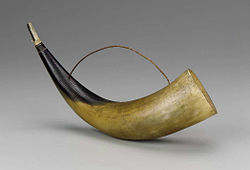The wild turkey and its hunting (1914) (14592189419)
Identifier: wildturkeyitshu00mcil (find matches)
Title: The wild turkey and its hunting
Year: 1914 (1910s)
Authors: McIlhenny, Edward Avery, 1872-1949 Jordan, Charles L., d. 1909 Shufeldt, Robert W. (Robert Wilson), 1850-1934
Subjects: Turkeys
Publisher: Garden City, N. Y., Doubleday, Page & company
Contributing Library: Smithsonian Libraries
Digitizing Sponsor: Biodiversity Heritage Library
View Book Page: Book Viewer
About This Book: Catalog Entry
View All Images: All Images From Book
Click here to view book online to see this illustration in context in a browseable online version of this book.
Text Appearing Before Image:
legs to alight,he saw me, and with a loud put-put checkedhis flight and shot up like a rocket. A gobbler will invariably alight within fifty toseventy-five yards of the roosting tree, accordingto the height they are perched from the ground;therefore one hundred and fifty yards is suffi-ciently near if your purpose is to call; but if youintend to stalk and shoot him in the tree, youwill do best if you show no part of your body;and especially keep the gun barrel out of sight.Many hunters will hide themselves but exposetheir gun, which is a great mistake, as the birdwill surely see the glint of light on the barrel. It is best, in my opinion, not to call while thegobblers are in the trees, for the reason that thegobbler is expecting the hen to come to him; andit will often happen that as long as you call, solong will he remain in the tree and gobble andstrut. I have had gobblers sit on their roostuntil 9 oclock and gobble because I kept yelp-ing. Having got into position, wait until your
Text Appearing After Image:
Cluck, put, put, there stands a gobbler, within twenty paces tothe left; he has approached from the rear THE LOVELORN GOBBLER 203 nerves are cool. The turkey hunter must havetime. Give a low, soothing cluck, then listencarefully, as the turkey may gobble the instanthe hears the cluck; perhaps two may answer,but we will confine our attention to one. If atwo-year-old bird, he will gobble before he thinks;but we will not allow you such an easy job as atwo-year-old. Suppose the gobbler is three yearsor over — he will straighten up his long neck andlisten some moments. He is not sure it was agenuine cluck, but he thinks it was, and dulydrops his broad wings, partly spreads his tail,and listens; then, Vut-v-r-r-o-o-o-m-m-i comesthe booming strut, and Gil-obble-obble-obble, ifhe dares this it is to elicit a call or cluck from youto make sure he is not deceived. Now call,Cluck, cluck, keow, keotv, keow/9 at once heanswers Gil-obble-obble-obble two or threetimes in a breath so loud and shril
Note About Images
Relevante Bilder
Relevante Artikel
Sucked trumpetSucked trumpet ist eine seltene, den Naturtrompeten formähnliche Gruppe von Aerophonen, bei denen der Ton mit den vibrierenden Lippen durch Ansaugen von Luft aus einem Hohlkörper erzeugt wird. Für die sucked trumpets hat sich noch keine deutschsprachige Bezeichnung etabliert und in der 1914 veröffentlichten Hornbostel-Sachs-Systematik ist keine den Blasinstrumenten analoge instrumentenkundliche Klassifikation einer Kategorie der „Sauginstrumente“ vorhanden. Das MIMO ordnete in einer Ergänzung von 2017 den sucked trumpets innerhalb der Trompeten-Gruppe (423) eine neue Untergruppe Sucked (tubular) labrosones (423.123.1) zu. .. weiterlesen




